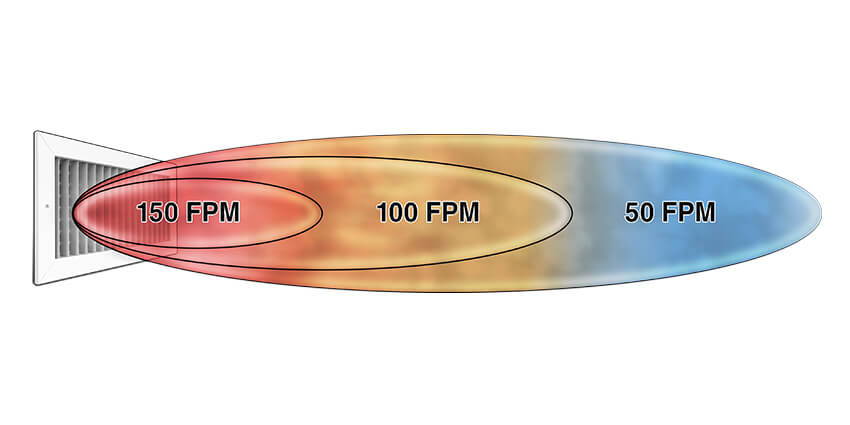Understanding GRD Performance Data and Applications

Grilles, Registers, and Diffusers (GRDs) are designed to enable the efficient distribution of conditioned air within a given space. Each type of GRD product offers unique advantages and disadvantages, making them suitable for specific applications. When it comes to selecting GRD products, engineers carefully evaluate the requirements of the space to ensure optimal thermal comfort for the occupants. ASHRAE, the American Society of Heating, Refrigerating and Air-Conditioning Engineers, defines thermal comfort as "a condition of the mind which expresses satisfaction with the thermal environment." Essentially, it means that people are not too cold or too hot, and the environment feels comfortable. The primary objective for engineers is to create an environment like this in which most occupants feel comfortable and content with the temperature conditions. According to ASHRAE, a thermally comfortable environment maintains the air properties below:
- Relative humidity: 30-60%
- Air Velocity: Less than 50 feet per minute
- Perceived temperature: 73-77⁰F
GRD manufacturers publish performance data to provide engineers with the information they need to correctly apply these products. The performance data for GRD products is tabulated by product size and airflow quantity. The airflow quantity is measured in cubic feet per minute or CFM. Typically, an engineer would already have specified performance in mind, so they would use the performance tables to determine which size they need to achieve that desired performance. For GRD products, three important metrics for measuring airflow performance are Throw Distance, Static Pressure (or Pressure Drop), and Noise Criteria.
Throw Distance
First, the throw distance is an important measure of how far the air will travel from the outlet of the device. Engineers aim to design a space with the most effective air distribution while maximizing occupant comfort. The average person cannot feel any air movement with a velocity of less than 50 feet per minute. In most applications, the target velocity for air movement is set below 50 feet per minute to avoid creating drafts or noticeable air movements. In some cases, like factories, the allowable air velocity can be higher, but for an office building or commercial area, maintaining a velocity of no more than 50 feet per minute is a good rule of thumb.
The throw distance is influenced by a couple of important factors, including the initial velocity of the air and the temperature difference between the conditioned air and the average temperature in the space. GRD manufacturers provide throw distance data to assist engineers in understanding how far the air will travel before its velocity drops to the desired threshold. Many manufacturers list throw data using three values: a throw distance for 150 feet per minute velocities, another value for 100 feet per minute velocities, and a third value for 50 feet per minute velocities.
 |
| Figure 1: Throw Distance Visualization |
For example, a GRD product might have a listed throw distance of 5-10-15 in the performance table. (Figure 1) These values indicate that the air from the GRD product will travel up to 5 feet before its velocity decreases to 150 feet per minute. Similarly, the air will travel up to 10 feet before reaching 100 feet per minute, and up to 15 feet before reaching the desired threshold of 50 feet per minute. As the air travels further from the outlet, it will continue to mix into the room and lose momentum which results in the air losing velocity.
By examining the throw distance data provided by manufacturers, engineers can determine the suitable placement and spacing of GRD products to achieve the desired air distribution pattern. They can ensure that conditioned air reaches the occupied zones effectively, creating a comfortable environment for building occupants. It's important to note that throw distance is not the only factor to consider when selecting GRD products. Other variables, such as the shape and design of the diffuser, the layout of the space, and the specific requirements of the project, also play a role in determining the optimal product selection. Now that we have discussed throw distance in detail, let's move on to discussing the importance of pressure drop in the performance of GRD products.
Static Pressure (Pressure Drop)
The static pressure (pressure drop) is a critical factor to consider when evaluating the performance of GRD products. It refers to the resistance that the airflow encounters as it passes through the grille, register, or diffuser. Understanding the pressure drop is important because it affects the overall efficiency of the HVAC system and the energy required to move the air.
When air passes through a GRD product, it experiences friction and resistance due to the geometry and design of the device. This resistance results in a pressure drop across the GRD. The pressure drop is typically measured in inches of water gauge (in. wg). The drop in pressure is the difference between the static pressure before and after the GRD device. In general, the static pressure of the airflow will decrease as the air travels through the system even when the duct is smooth and straight. But every time the ductwork changes direction, constricts, or expands in size, this will also contribute to the overall pressure drop. It’s important to accurately estimate the total pressure drop of the system to properly size out the fan system. The fan system must have the capability to produce enough static pressure to overcome all of the pressure drops. Every GRD product contributes to the overall pressure drop, so minimizing the pressure drop of a GRD product can help to reduce the overall energy required for the system.
Most GRD manufacturers publish pressure data for their products. This data is typically presented in the form of a table that illustrates the pressure drop across the product at various airflow rates or velocities. Engineers need to consider the pressure drop of GRD products to ensure that the HVAC system operates efficiently. Excessive pressure drop can lead to increased energy consumption, reduced airflow, and even system malfunctions. On the other hand, selecting a GRD with low pressure drop can optimize the performance of the HVAC system and contribute to energy savings.
By selecting a GRD with an appropriate pressure drop, engineers can ensure that the HVAC system operates effectively and delivers the desired airflow to each space. Now that we've covered pressure drop, let's move on to the third performance metric: noise criteria.
Noise Criteria
Noise criteria, often abbreviated as NC, is a measure of the acoustic performance of GRD products. It quantifies the level of noise generated by the airflow passing through the grille, register, or diffuser. Noise criteria is an essential consideration, as excessive noise can significantly impact occupant comfort and productivity.
The noise emanating from GRD products can come from various sources, such as airflow turbulence, fan noise, and the products vibrating due to high velocities. Manufacturers conduct laboratory tests and measurements to determine the noise criteria for their products for a range of airflows. Noise criteria is typically expressed as a numerical value with lower values indicating quieter operation. The specific noise criteria target for a given application depends on the environment and the occupant's sensitivity to noise.
Engineers need to consider the noise criteria when selecting GRD products to ensure that the resulting noise levels are within acceptable limits for the intended space. An office building might have a recommended NC level of NC 25, while a quieter location like a library or concert hall could have a recommended NC level of NC 20. For a space like a factory where sound levels are not critical, the average NC level could be NC 60 - NC 70. In general, anything under NC 20 is very difficult for people to hear. Typically, NC levels less than 20 are not tabulated unless the products are designed to function at very low sound levels. Noise criteria measurements help engineers evaluate the acoustic performance of the products and make informed decisions. By selecting GRD products with appropriate noise criteria, engineers can ensure that the HVAC system operates quietly, minimizing disturbance to occupants and promoting a comfortable indoor environment.
Specifying GRD Products
Now that we have discussed the metrics of throw distance, pressure drop, and noise criteria, it is crucial to understand the importance of considering these metrics in the selection and specification process of GRD products. By taking all three of these performance metrics into account, engineers can make informed decisions that ensure optimal performance, energy efficiency, and occupant comfort.
Analyzing throw distance enables engineers to determine the appropriate placement and spacing of GRDs to achieve the desired air distribution pattern. This helps to ensure that conditioned air reaches all occupied zones effectively, creating a comfortable environment for building occupants. Additionally, evaluating the pressure drop of GRD products is essential for the efficient operation of the HVAC system. Excessive pressure drop can result in increased energy consumption, reduced airflow, and even system malfunctions. Lastly, noise criteria plays a crucial role in occupant comfort. Excessive noise levels can negatively impact productivity and overall satisfaction within a space.
By carefully considering these metrics along with other factors, engineers can specify GRD products that deliver the desired airflow performance, energy efficiency, and occupant comfort.
For more information on GRD products click here or contact your nearby Greenheck representative.
Grilles, Registers & DiffusersRead Next
How Do Thermally Actuated Diffusers Conserve Energy in Commercial Buildings?
Evaluating Finish Coat Processes for Grilles, Registers, and Diffusers
How to Improve HVAC Systems by Making a Fraction of an Inch Change



from